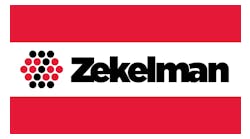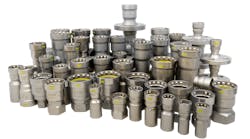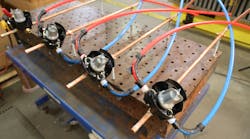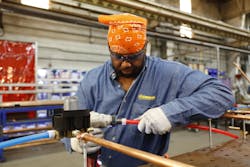By Kim Bliss
In the world of commercial construction, becoming more efficient and increasing productivity is the name of the game when delivering projects that meet (or improve) project schedules and budgets. However, while efficiencies in almost every other sector of industry have seen improvements over the past several decades, that’s not the case for construction.
In fact, some would argue it’s going in the opposite direction, with efficiencies on construction job sites seeing little improvement, thanks to the skilled-labor shortage and fewer new recruits entering the trades. In fact, the Mechanical Contractors Association of America now states only 32 percent of labor hours on a commercial job site are spent on direct installation of equipment and piping systems.
This means that for an eight-hour workday, only about two-and-a-half hours are spent on actual productive, profitable activities. The remainder of the workday could include things like material handling, equipment setup, jobsite cleanup, meetings, breaks, rework, and testing setup.
Some of these activities do help contribute to the installation and are important to the project. But the challenge actually lies in executing these activities more efficiently during the time spent on the job site.
This is why the most positive impact on a project happens during the preconstruction phase. Strategic planning and coordination at the very beginning of a project provides the greatest benefits on total project costs, schedule, and profitability.
Start smart
Using state-of-the-art technologies at the beginning of a project will add greater efficiencies further along in the project cycle. One of the most effective resources for accomplishing this is creating designs with 3D coordination and clash detection. This software ingenuity is far superior and more effective than traditional 2D designs when it comes to project efficiencies.
Adding clash detection to the 3D model coordinates systems across multiple disciplines—plumbing, mechanical, electrical, and structural—to reveal project areas where systems will “clash,” or literally run into each other. Finding this out during the concept and design stages can save significant labor time and costs once installers are on the job site.
For example, a plumber may be planning to run pipe through the same space the HVAC contractor is planning to run ductwork. Or there might be plans to locate equipment where a wall or other structural component is supposed to go.
Coordinating the project with 3D modeling and clash detection puts all the models together for plumbing, mechanical, electrical, and structural, and lays out all the systems into one 3D model, based on the owner’s requirements. This eliminates conflict on the job site, wasted time coming up with a resolution, and added costs that cut into profit margins.
Plan to prefab
Once a comprehensive design is in place, adding prefabrication to the plan can potentially shave weeks off a project schedule. Prefabbing repeatable assemblies in a predictable, controlled, factory-type environment offers time-saving, cost-saving, and quality-installation advantages.
Having newer or less-skilled workers in a controlled environment where they can sharpen their skills is a great way to invest in your workforce and also ensure they are doing the job right the first time. Plus, supervisors can easily do quality checks on row after row of prefab racks, rather than walk for miles on a job site.
After making dozens, hundreds, or potentially thousands of prefabricated jigs or racks in a factory environment, a simple haul to the job site to put them in place greatly reduces onsite material handling and assembly to add considerable efficiencies to a project.There are several different prefabrication applications for commercial projects. For example, racking in prefabrication involves taking a number of spools and attaching them to hangers and supports, then assembling them offsite and shipping them to the job site when ready. They are then set in place as a single unit.
Multi-trade racking includes the material coordination and installation from several trades. For example, you could have plumbing, mechanical, and electrical work all installed on one rack. Once the rack is complete, the whole assembly is delivered to the job where the various trades responsible for the rack will make their tie-in connections.
The efficiencies of this concept are substantial. Professionals in the commercial building industry are continuing to move toward this model as an effective method for saving time, money, and weeks on a construction schedule.
Tie it together with PEX
Beginning with a smart design and incorporating prefabrication are definite ways to add efficiencies to a commercial project. However, adding PEX pipe and fitting to the project is where the time-, labor- and cost-savings really come to fruition.
With its introduction to North America more than 40 years ago, PEX has evolved from a residential radiant heating piping product to a domestic water and mechanical hydronics solution that is meeting several needs of the commercial industry.
For example, in a project using prefabrication, the lighter weight of PEX is a big factor. This is because a 20-foot length of 3" PEX pipe weighs a mere 26 lb., while copper is more than double, at 67 lb., and steel is a whopping 152 lb. All that weight makes a big difference when moving the product and getting it ready for prefabrication.
Another big difference is the connection system. For PEX, you can use various systems, such as crimp, clamp, compression, expansion, or push-to-connect. However, most professionals choose ASTM F1960 expansion, because it cannot be dry-fit. In addition, it’s the only PEX connection that actually gets stronger over time. Finally, expansion connections are very durable in transport, which is important in a prefab application.
Add to those benefits the fact that PEX is flexible for fewer required connections, offers stable material costs, and resists corrosion, pitting, scaling, and rust, and you can see why commercial project designers and specifiers are turning to PEX in place of metallic piping systems.
When you’re beginning to plan your next commercial project and you need to meet tight budgets and deadlines, think of these areas where you can add efficiencies to bring greater success to your business.
If you are interested in learning more about PEX pipe and fitting systems, visit the Plastics Pipe Institute website at plasticpipe.org or the Plastic Pipe and Fittings Association website at ppfahome.org.
Kim Bliss is the content development manager at Uponor. She can be reached at [email protected].



